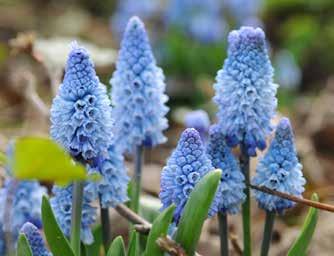
1 minute read
Climate-adaptive planting
Bulbs Between Grasses And Specific Prairie Plants

Advertisement

A prairie garden is a low-maintenance planting system that creates a natural balance between plants. The combination of strong perennials and ornamental grasses gives a completely different picture in colour and structure five to six times a year.
The image is attractive all year round. Because many prairie plants start late, bulbous plants are used for colour in the spring. Suitable prairie garden varieties are allium, camassia, leucojum, ornithogalum, iris, botanical tulips and daffodils.
2 Special Prairie Bulb Mixtures
Prairie mix white - for 5 m2
A bulb mixture of mainly white flowering varieties. Specific for a prairie garden with white crocuses, tulips turkestanica and ‘Spring Green’, daffodils ‘Thalia’ and ‘Stainless’, Hyacinthoides white, Leucojum ‘Gravetye Giant’, white allium and white camassia.
Prairie mix pink - for 5 m2
A bulb mixture of mainly pink-flowering varieties. Specific for a prairie garden with pink chionodoxa, tulips saxatilis and ‘Greenland’, daffodils ‘Thalia’ and ‘Pink Charm’, Hyacinthoides pink, Leucojum ‘Gravetye Giant’, Allium ‘Purple Rain’ and blue camassia.
Bulbs In Wet Growing Places In Urban Areas And Gardens
A whole new form of specially designed wet locations are so-called wadis. A wadi actually works just like a floodplain or a river bed. It is a designated place that is occasionally completely flooded. At this location, the water can slowly sink in and is then slowly transported away to the ground and surface water. In this way it protects the sewage system.
A wadi system is designed to collect a certain volume of water. The wadi is usually calculated for a maximum water depth of around 30 to 40 cm and is then under water for a short period, usually no more than 24 hours. Outside these inundation periods, the wadi is often dry for a long time.
A rain garden is a sunken planting area with a flat bottom, planted with a variety of plants and shrubs. It is intended to temporarily collect water after a heavy rain shower and let it sink slowly. The plants serve to retain the water, to allow it to infiltrate the soil better and to allow it to evaporate. Like a wadi, a rain garden is dry most of the time. Below are the main flower bulb types and cultivars for wadis, rain gardens and other humid locations:
• Camassia cusickii, leichtlinii & quamash

• Nectaroscordum siculum

• Leucojum aestivum ‘Gravetye Giant’
• Fritillaria meleagris
• Narcissus jonquilla hybrids
• Galanthus nivalis
• Muscari azureum & botryoides









